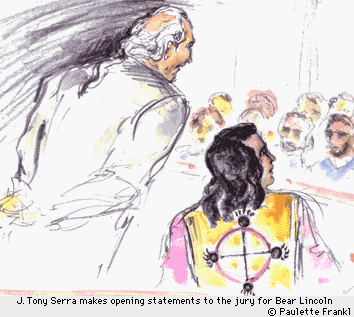Bear Lincoln Murder Trial Begins
by Nicholas Wilson

Bear Lincoln Murder Trial Beginsby Nicholas Wilson |

|
|
UKIAH, CA -- In a murder case
already famous for its symbolism, the opening of Bear Lincoln's trial offered new contrasts everywhere you looked.
As the trial began July 29, Lincoln, a Wailaki Indian who follows traditional ways, is wearing a specially-made deerskin vest decorated with a circle and drawn bear claws pointing to the four directions. Facing him is an all-white jury; the prosecutor used peremptory challenges to eliminate all persons of color, including three Native Americans. A squad of armed deputies guard the hallway and courtroom itself, many of them with Secret Service-style radio earplugs. On opening day, plainclothes officers and detectives wear symbolic green ribbon pins on their clothing in memory of the slain deputy. Under heavy security, media, the public, and defense attorneys pass through a large metal detector and security checkpoint. Bags are searched for weapons, cameras and tape recorders. But there is no search for the widow and other family members of slain Deputy Bob Davis, who are personally whisked past the security station by Sheriff James Tuso to their seats in the front row nearest the jury box, where he sits with them. All wear the green ribbons; Davis and the sheriff were personal friends. The family of slain Indian Leonard Peters, also a victim in the incident, receives no such privileged escort; they wait in line. Also waiting to be searched are Bear Lincoln's mother Lucille and aunt Lavinia Lincoln, both faithful regulars at the long series of pretrial hearings and jury selection. Outside the courthouse is the sound of traditional Indian drumming and chanting. Only 35 seats in the jammed courtroom are available to the public, and easily four times that many Lincoln supporters came to see the beginning of what many knew would be an important and historic trial. Many picket, waving signs at passing traffic: "The truth shall set Bear free -- Why is the jury all white? -- Time for Truth Dennis Miller, -- Investigate the murder of Acorn Peters -- A jury of your peers?????"
| ||
|
After
an introduction and
explanation of procedure by Judge John J. Golden the jury heard opening
statements from prosecution and defense.
Judge Golden told the jury that the purpose of opening statements was to give them a preview of the evidence so they would be aware of its significance when it is presented. Evidence is often in bits and pieces, he said, and opening statements are like the picture on the a jigsaw puzzle box; it helps you see how the pieces fit together. Deputy District Attorney Aaron Williams opened the case for the prosecution by describing his interpretation of events of April 14, 1995.
| ||
|
In contrast
to Williams' low-key delivery, J. Tony Serra gave only a
preview of some of the flamboyance and passion for which he is famous,
modulating his voice sometimes to a barely audible whisper, then building
to a resounding roar. Courtroom artist Paulette Frankl has been watching
and sketching Serra in action for several years, working on a book project
with text by Serra. Her assessment was that we have so far seen him reach
only a fraction of his full passionate intensity.
Serra presented surprising new evidence, concealed until now because of the gag order. Courtroom observers were shocked to learn that investigators found a drip trail of blood, testing consistent with that of Deputy Bob Davis, leading away from the scene toward Bear Lincoln's house. That implies that the officer pursued Bear Lincoln, contradicting all previous scenarios advanced by law enforcement.
Of the 52 spectator seats in the courtroom, 35 were filled by members of the public whose numbers were randomly drawn, nine were reserved for the media, four for members of the Davis family, and a pair each for the families of Lincoln and Peters. One of Bear Lincoln's aunts and many others were angry when they weren't admitted after getting up in the wee hours and traveling long distances to attend. Many media representatives also were not admitted, including Pacific News Service. No photographing, videotaping, or sound recording is permitted, with a minor exception allowing sound recording for reporter's notes only. Anderson Valley Advertiser reporter Mark Heimann was denied a press seat, and was not lucky in the lottery for a public seat, but got in when a lottery winner generously handed him his ticket. The trial is expected to last about four months. |
Albion Monitor August 5, 1997 (http://www.monitor.net/monitor)
All Rights Reserved.
Contact rights@monitor.net for permission to reproduce.
